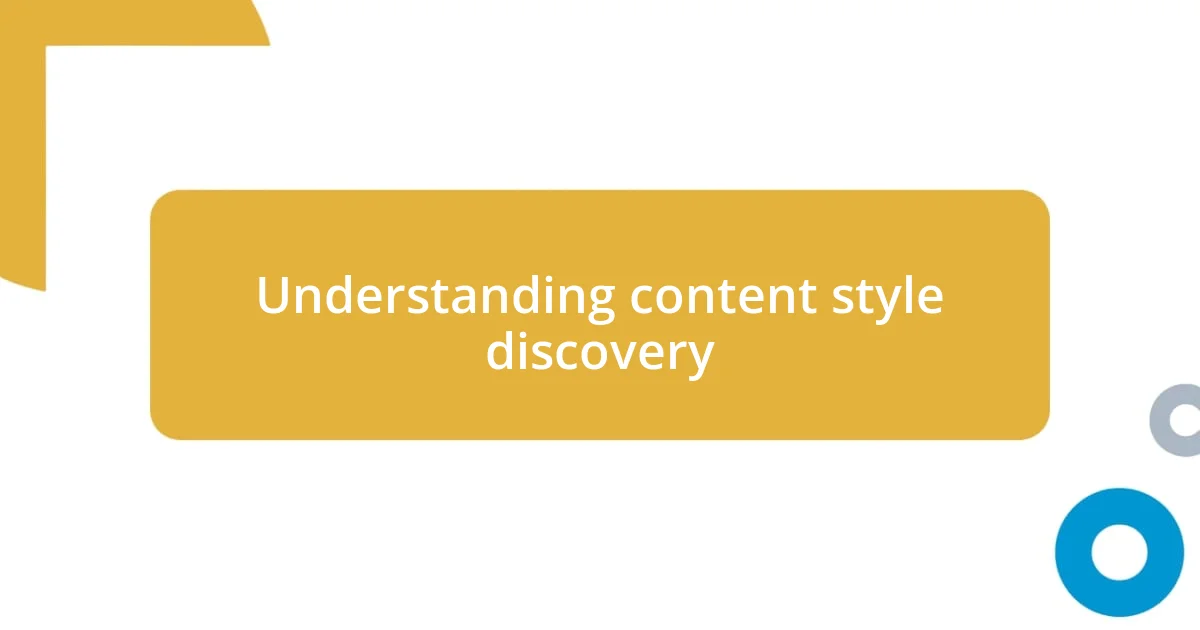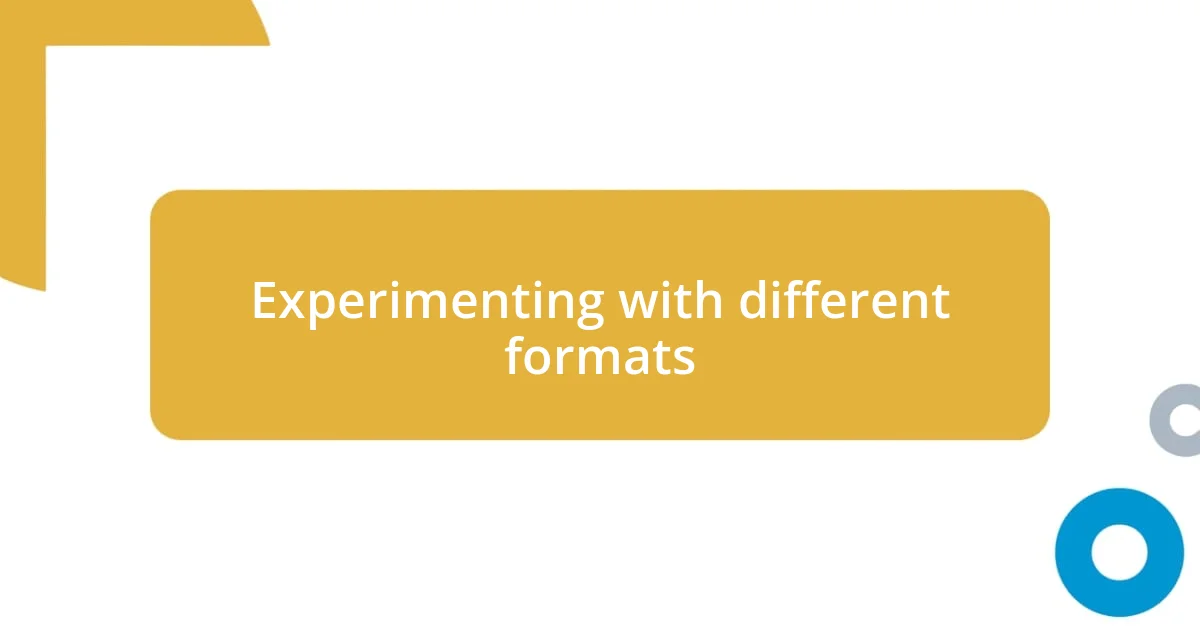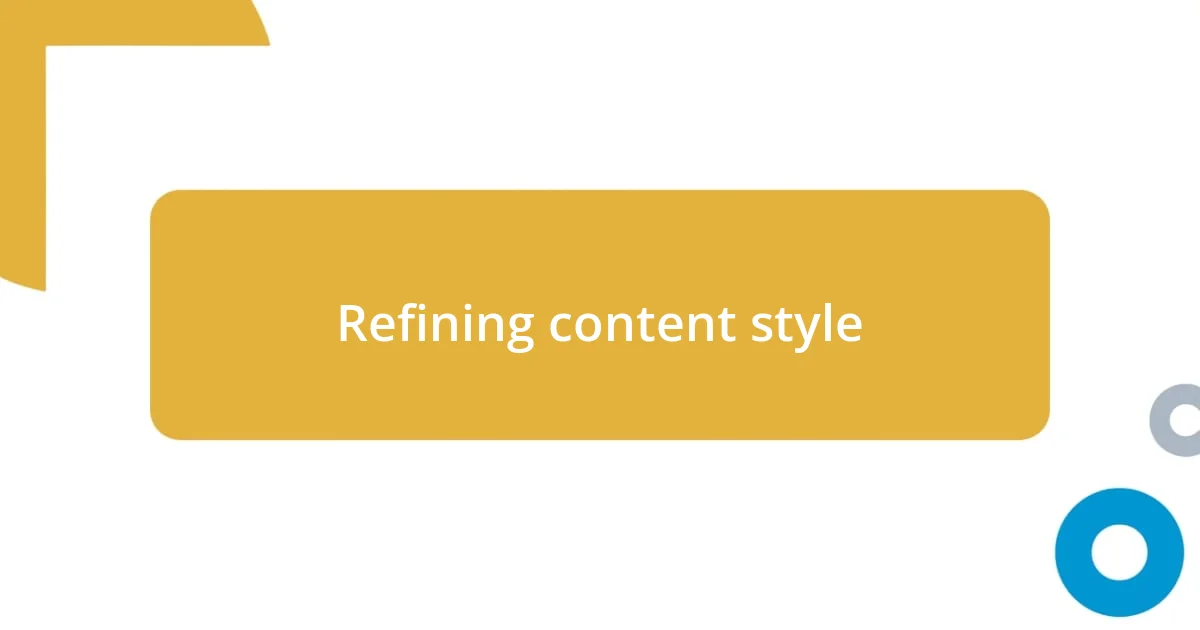Key takeaways:
- Discovering a unique content style often involves spontaneous writing, reflection, and experimenting with different formats to foster creativity and enhance audience engagement.
- Receiving constructive feedback from peers is crucial for refining writing, allowing for emotional depth and authenticity in storytelling.
- Establishing a unique brand identity involves defining personal values, maintaining consistency in style, and fostering genuine connections with the audience through shared experiences.

Understanding content style discovery
Understanding content style discovery is a deeply personal journey. I still remember the moment I stumbled upon what felt like my voice. It was during a late-night brainstorming session when I decided to write spontaneously without overthinking each word. This experience taught me that sometimes, allowing emotions to flow freely can unlock a style that feels uniquely my own.
Moreover, I realized that exploring different angles and formats could help me refine my content style. I experimented with short, punchy posts one week and longer, in-depth articles the next. This trial-and-error approach not only enhanced my creativity but also invited my readers to engage with me in varied ways. Have you ever felt stuck in a particular format? That’s where discovery often begins—by pushing boundaries and exploring new possibilities.
Ultimately, understanding your content style involves continued reflection and adaptation. There are days when I revisit old pieces and recognize how much I’ve evolved as a writer. It strikes me that this evolution is a part of who we are. How do you assess your growth? Embracing this process of discovery not only enriches our content but also connects us more profoundly with our audience.

Identifying personal writing voice
Finding my personal writing voice was a gradual process, heavily influenced by moments of introspection. There was one afternoon when I reread an old blog post that I had written while feeling particularly vulnerable. The rawness of my emotions leapt off the page, and I recognized that authenticity was the key to connecting with my readers. It dawned on me that my voice didn’t need to conform to anyone else’s standards; it simply had to be genuine.
To help clarify your own voice, consider these pointers:
- Reflect on Your Influences: Think about writers or authors whose work resonates with you. What aspects of their style do you admire?
- Experiment with Tone: Play around with different tones—serious, humorous, conversational—to see what feels most natural.
- Seek Feedback: Share your writing with trusted friends or peers. Their insights can help you identify the characteristics that shine through in your work.
- Practice Mindful Writing: Set aside time for free writing, allowing your thoughts to flow without judgment. This can reveal hidden patterns in your voice.
- Review and Adapt: Periodically revisit old pieces. Recognizing changes in your writing can illuminate how your voice has developed over time.

Analyzing successful content examples
Analyzing successful content examples is an enlightening process. I often find myself studying the works of writers who have captured my attention. For instance, I once came across an article that effectively combined storytelling with actionable insights. The writer had an uncanny ability to weave personal anecdotes into practical advice. This not only made the content relatable but also fostered a genuine connection with the audience. It made me question: how do I integrate my own experiences in a way that adds value to my writing?
A particularly striking example I analyzed was a blog that utilized a seamless blend of visuals and text. The images were strategically placed to enhance the storytelling, drawing readers deeper into the narrative. This taught me the significant role of visual content. It inspired me to rethink how I use visuals in my work. Have you noticed how a powerful image can evoke emotions that words sometimes can’t?
Through this exploration of successful examples, I found that clarity and brevity are paramount. One writer I admire masterfully distills complex ideas into easily digestible nuggets of information. I realized that my own content could benefit from this clarity. Distilling information forces me to focus on what truly matters, ensuring that my message resonates with my audience.
| Content Type | Key Feature |
|---|---|
| Storytelling Blog | Integrates personal anecdotes for relatability |
| Visual-Focused Article | Uses images to enhance emotional engagement |
| Informative Newsletter | Clarifies complex ideas into concise summaries |

Experimenting with different formats
Experimenting with different formats was a game-changer for me. I remember the first time I decided to try video content; I was nervous and unsure of how my personality would translate on screen. After filming my first clip, I was surprised at how my passion shone through. There’s something exhilarating about sharing your ideas while being visually present. I felt a stronger connection with my audience.
Visual storytelling, like creating infographics, also opened new doors for expression. I once transformed a complex research topic into a simple visual that conveyed my message in just a few frames. The satisfaction of seeing my audience engage with something so straightforward was incredible. Are you also finding that visuals make thoughts clearer and more engaging?
Additionally, I experimented with formats like podcasts, which allowed me to delve deeper into subjects through conversation. There was a moment during a guest interview when we riffed off each other’s ideas, and I realized dialogue could bring nuances that writing sometimes flattens out. Have you ever experienced that magic of a spontaneous conversation revealing new insights? Embracing various formats has not only broadened my skill set; it’s also taught me how to connect more authentically with diverse audiences.

Seeking feedback from peers
Receiving feedback from peers was one of the pivotal steps in honing my unique content style. I vividly remember a workshop where I shared my writing with fellow budding creatives. Their insights were invaluable—they pointed out what resonated with them and where I tended to ramble. It felt liberating to hear diverse perspectives; it made me realize that my voice, while personal, could still be refined to connect better with others.
One of the most striking moments came when a colleague noted that my storytelling lacked emotional depth. It stung at first, but I held on to that feedback. I started experimenting with more vivid imagery and emotions in my content, and the transformation was exhilarating. Have you ever felt that moment of realization that changes everything? For me, it was like turning on a light switch; suddenly, my writing felt alive.
I also found that group critiques inherently create a supportive atmosphere for growth. In those sessions, I learned to accept constructive criticism as a necessary part of the creative process. I would often ask my peers: “What part of my content feels most authentic?” Their answers not only guided me but deepened my understanding of my writing identity. Seeking feedback has turned into a nurturing dialogue; it’s a practice I cherish—what about you? Do you seek similar conversations to shape your craft?

Refining content style
Refining my content style involved a deep dive into self-awareness and continued learning. After initially feeling confident in my writing, I had a moment where I reread some older posts and realized they didn’t reflect my current perspectives. It struck me—my voice should evolve as I do. Has that ever happened to you, where you look back and feel a sense of disconnect from your own words?
One of the most rewarding aspects of this journey was discovering the power of authenticity. I remember attending a conference where an inspiring keynote speaker shared their struggles openly. Listening to their raw honesty prompted me to reflect on my own writing. I decided to incorporate more personal experiences into my pieces, creating a space for genuine vulnerability. That decision not only made my content resonate more with readers but also helped me forge a deeper connection with them. Have you ever felt the impact of sharing a personal story?
Ultimately, parsing through my content and identifying what felt most natural became a crucial process. I started keeping a journal where I jotted down phrases and techniques I loved, like metaphors or rhythmic sentences. There were moments when I’d write something that truly felt like “me,” and I’d relish those discoveries. Isn’t it fascinating how tiny moments of clarity can shift how we create? This ongoing exploration of my style has become a journey of self-discovery, and it’s one I genuinely cherish.

Establishing a unique brand identity
Establishing a unique brand identity is like crafting a signature tune; it needs to resonate with your audience while staying true to who you are. I recall the moment I decided to define my values clearly. Sitting at my desk, I scribbled down words that represented my essence: creativity, authenticity, and a dash of humor. This simple exercise helped me anchor my content and ensure every piece echoed these core beliefs. Have you ever tried similar techniques to identify your values?
I’ve found that consistency is critical when it comes to branding. For instance, I consciously adopted a vibrant visual style and a conversational tone in my writing. When I started using consistent color palettes and typography across my platforms, I noticed an increase in recognition. It made me wonder, how might sharing your distinct visual identity transform how viewers connect with your work?
Connecting with my audience was a gradual yet fulfilling process. I remember the first time a reader reached out through social media, expressing how my writing made them feel understood and less alone. That moment was pure magic! It reinforced my understanding that a unique brand identity isn’t just about me—it’s about what my content makes others feel. Building relationships through shared experiences has ultimately shaped my identity as a creator; do you consider this connection when developing yours?














